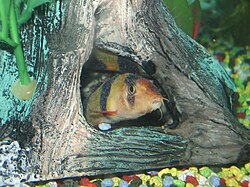Ichthyophthirius multifiliis
Ichthyophthirius multifiliis, also called "white spot disease", "ick" or "ich" is a disease that causes little white spots on fresh water fish. It is one of the most common parasites of fish. It often affects pet fish in tanks and ponds, as well as farm-raised food fish species. Wild fish populations can also get the parasite.
Life cycle
Ich is a parasite, it can only survive by living on the skin of the fish, this is called being "obligate". The parasite moves by a fish carrying it, other animals, or even humans. The life cycle has three stages: tomont, theront, and trophont. The tomont stage is the adult stage of the parasite. When this adult tomont leaves the fish, it falls to the bottom of the pond. Once the tomont falls to the bottom, it forms a thin cyst wall. Within that cyst wall the tomont begins to divide, creating thousands of tomites. Once all the tomites are made, they are released into the water. Once this occurs, the tomites then develop into an elongated form and are then known as a theront. Theronts are the developmental stage that then can swim to the fish and burrow itself into the epithelial skin. They do this by using a penetrating gland. What makes them an obligate parasite is that if they are not able to penetrate the fish’s skin they will die, so to survive, they need to get into the fish. Once they are in the fish’s skin they are then known as trophonts. The trophonts are protected from the chemical treatment in aquariums or ponds by the fish’s skin, and therefore it is difficult to get rid of them once the fish is infected. The trophonts then mature by feeding on the fish and become adults. The life cycle continues when the adults fall off again. The only stage that can be killed in the water is the tomonts and the theronts. [1]
Also interestingly, the I. multifiliis life cycle from birth to death depends on the temperature of the water. In warm water, 25 °C (77 °F), the parasite's whole life cycle can take place in seven days. In cold water, 6 °C (43 °F), it can take up to eight weeks.
Disease
The disease starts when the parasite digs into the skin of the fish. This causes swelling and white spots to form. After a few days, the parasite turns into a trophozoite, a jelly-like substance.[2] This falls off the fish and lives on the bottom of the tank. Inside the jelly are hundreds of baby parasites called tomites.[2] These eventually can swim by themselves and go looking for another fish to live in.
Fish may have Ichthyophthirius multifiliis without there being anything to see. Fish owners need to be careful about where they get their fish from, as the disease can spread very easily. There are a number of different ways to try to get rid of the parasite. One method is to heat the water to kill the parasites in the water before they can infect the fish. Another method is to add salt to the water, or put the fish into a salt water bath. The water should be changed frequently to remove the parasites. Chemicals are also available which will kill Ichthyophthirius multifiliis. All these treatments need to be carefully planned for the type of fish species.
Fish with the disease will:
- Stop eating and lose weight
- Breathe quickly
- Hide
- Rest on the bottom of the tank
- Rub and scratch against objects
Treatment
If you find that your fish is infected, here are some simple procedures to follow to help your fish.
- Formalin prolonged immersion
- Formalin/malachite green prolonged immersion
- Salt prolonged immersion
- Copper prolonged immersion (ponds only)
- Raise the temperature to >30 degrees Celsius or 86 degrees Fahrenheit for 10 days.
- Formalin bath weekly (until fish is cured)
- Transfer fish to a new aquarium daily for 7 days at 25 degrees Celsius or 77 degrees Fahrenheit
Ichthyophthirius Multifiliis Media
References
- ↑ Durbow, Robert M. (1998). "ICH (White Spot Disease)". S2CID 38943166.
{{cite web}}: Missing or empty|url=(help) - ↑ 2.0 2.1 "Ick in fish". Dog Breed Info Center. Retrieved 2009-10-18.
- ↑ Noga, Edward J. (2011). Fish Disease: Diagnosis and Treatment. John Wiley & Sons. ISBN 9781119949466. Retrieved April 20, 2018.
Other websites
- White Spot Archived 2011-04-24 at the Wayback Machine




